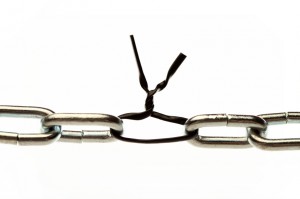Which of these teams would you rather be on?
The first is famous for taking on highly dangerous and seemingly impossible challenges. Its individual members are known for their high self-confidence, tough-mindedness, and indomitable wills. They are the ultimate can-do optimists.
The other team obsesses about planning; they envision everything that can possibly go wrong, they build in as much room for error as possible before they try anything, and they do everything they can to stack the odds in their favor before acting. Call them the ultimate pessimists.
Most people, especially readers of this blog, would choose the first. After all, optimism is practically a religion in America. The idea of a positive mental attitude has become so ingrained in American thinking that it verges on political incorrectness to question it. You can never win an argument with someone who says that you can do anything you set your mind to, because they take it on faith. A positive attitude is often based on faith and emotion, and anyone who points out practical deficiencies and obstacles is seen as lacking in the right stuff.
But when you take a closer look at what the experts say about it, the picture that emerges is a bit more complicated. In fact, the descriptions above both describe the same team: US Navy SEALs. It turns out that optimism and pessimism are not polar opposites—they can coexist in the same person or team at the same time, and the right mixture at the right time can be critical to your success.
Optimism and pessimism are not opposite ends of a spectrum. They can coexist in the same person at the same time
In The Positive Power of Negative Thinking, Julie K. Norem tells us that optimism and pessimism are not actually opposites, as two points on a straight line. Think of each characteristic as being at right angles to each other, as in each axis of a graph. In this way, it’s possible to understand that high (or low) levels of both optimism and pessimism can coexist in one person at the same time.
Combine these two attributes, and you’re at the top right of the scale. You have big-picture optimism, but fine-detailed pessimism. You have high confidence not because you ignore the dangers, but precisely because you acknowledge and respect them, and then do everything possible to avert, mitigate, or deal with them. And because you’ve thought about them, your mind is better prepared because you’ve probably mentally rehearsed the situation already. Norem calls this defensive pessimism, but I prefer the term positive pessimism.
The right mixture at the right time can be critical to your success
If you think of a competition or major undertaking as a process, there are three distinct phases. The first is the decision whether to play. The second is the preparation. The third is the actual performance.
Whether to play: You have to be optimistic to take on the challenge.
Most people will not undertake something challenging unless they think they have a chance of succeeding. Po Bronson in his book, Top Dog: The Science of Winning and Losing, tells us that optimists lose more often, for two reasons. First, they take greater risks, and second, they are much less realistic in assessing their own abilities. (Which is one reason you see people make complete idiots of themselves on shows like American Idol.) But optimists also win more, because they compete more often, which is why an unknown long-shot from Illinois to run for president and actually win.[1]
Yet at this stage some negative thinking can also help. Negative thinking is about realizing that it’s not true that you can do anything you set your mind to. Accepting your limitations frees you to focus on the things you can do, and developing those strengths you do have. A positive thinker will take a bad shot in hopes of making it; a negative thinker will help the team by passing to someone who is open or who has a better chance of making it. A coach, or any other leader, will work with the limitations of his individuals to form a better team.
Pessimism and negative thinking during the preparation phase can increase your chances for success.
Bobby Knight, in his book, The Power of Negative Thinking, makes a strong case to counterbalance the idea that you should always be positive. Although the common wisdom tells us that you can’t be a winner without positive thinking, Knight’s lifetime winning record in NCAA basketball history, adds weight to his views.
One of Knight’s themes is that determination and a positive attitude are no substitute for hard work, preparation, and planning. He quite correctly attacks the “don’t worry, be happy” school of success. He tells us that in his experience more most basketball games are not won, they are lost. In other words, mistakes do more to determine the loser than positive thinking and desire and will to win determine the winner.
Negative thinking is similar to Andy Grove’s philosophy that only the paranoid survive. It’s about being fully aware of all the things that could go wrong, and then preparing so that they don’t, or so that you can overcome them when they do happen.
Ironically, when pessimists do their job right, no one notices. Heidi Grant Halvorson tells the story of the Mars Climate Orbiter which missed its target by 100 kilometers, costing NASA $125 million. The fault was traced to a unit conversion error: the NASA engineers worked in metric and the Lockheed Martin worked in English units. Potential errors such as this are caught all the time by people who pay close attention, but “No one says ‘Way to convert those units from inches to centimeters, Bob. You just saved us $125 million dollars and a boatload of humiliation. You rock!’”[2]
During the “game”, it pays to think positive. Playing not to lose can actually decrease your chances of winning.
Once all the preparation is over and you’re in the arena, it’s time to trust your training and preparation and focus all out on the positive aim of winning.
As Bronson says, “The hallmark characteristics of playing to win are an intensification of effort and continuous risk taking. The equivalent for playing not to lose is conservatism and trying to avoid costly mistakes. Under intense pressure, though, having a strategy of avoiding mistakes leads, by itself, to more mistakes. This is the paradox of playing not to lose.”
As evidence, he cites these extraordinary statistics from professional soccer matches that end in penalty kicks to determine the winner. In soccer, the true odds of making a penalty kick are 85%. Yet, when kickers are in the position where their kick will win the match, they make it 92% of the time. When they have to make the last kick to avoid a loss, they make it 62% of the time.
Positive pessimism is not an oxymoron—it’s a highly adaptive, effective and professional response to difficulty and risk. Positive pessimism does not let anxiety prevent action—it harnesses anxiety to produce positive action, when it’s applied at the right time.





